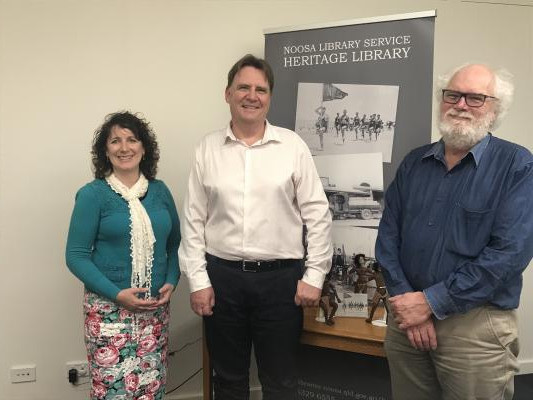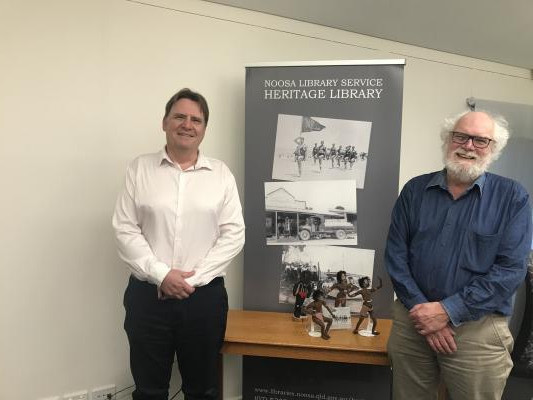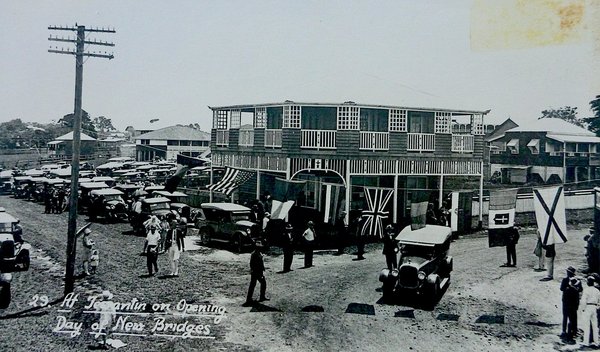A somewhat kitsch souvenir Aboriginal doll, a thick file of coroners’ reports into coastal drownings, an Indigenous jokester’s prank on our first tourists – these are the curious threads that bind Noosa’s ambitious first Historians-In-Residence program.
Commissioned and funded by Noosa Council Heritage Library, the ground-breaking history program early this year invited applications from qualified and experienced historians to become residents at Noosa Library while they researched and wrote papers on lesser known aspects of our Noosa story. But eminent Queensland historians Dr Jonathan Richards and Dr Ray Kerkhove had been selected for less than a week when the Covid-19 lockdown tore a gaping hole in the planned program of field research and interaction with the local community.
But, says Heritage Co-ordinator Jane Harding: “While Covid has changed the shape of the program a little and it’s going to run a bit behind schedule, we’ve been able to progress it this far by virtue of the fact that these guys have so much already in place, so much stockpiled material that they’ve been waiting for an opportunity to place in context. Fortunately, they both had enough background information at home to make a lot of progress remotely. Now that research facilities have opened again, they have the opportunity to fill in the missing pieces.”
Jonathan Richards is one of Queensland’s foremost archival researchers, and is the author of The Secret War, the most authoritative account of the Native Mounted Police and the colonial frontier war. Ray Kerkhove, who describes himself as “more an interviewer than an archivist” has been associated with the University of Queensland’s Aboriginal Environments Centre since 2017, and has also been a Visiting Fellow at Griffith University’s Harry Gentle Resource Centre, which focuses on pre-1859 Queensland heritage. His expertise is Indigenous historical landscapes and material culture, especially of southern Queensland.
Although both these leading academic historians have frequently focused on Aboriginal themes, for the Noosa project they have researched areas of our history that cover European settlement and integration, as well as the First Nations.
Jonathan’s starting point has been the village of Cooran. He says: “Cooran is the oldest town in Noosa Shire and I think they feel a little bit overlooked. It was the halfway point on the Gympie to Tewantin coach route, then the railway came through and started a long, slow decline. When the rail came in Cooroy eclipsed Cooran (as the entry port for Noosa) so you had this whole history of one town against the other. Eventually they did build the Cooroy-Tewantin road down that difficult hill, so that’s the basis for my second story, incorporating the Noosa branch railway plan, which is a story in itself.”
“Then,” says the learned historian, “I’m stoked to be putting to good use my morbid fascination with inquests over many years by preparing a history of drownings (Jonathan occasionally delivers a popular presentation called ‘Death at the Beach’) in the Noosa River. The common theme is boats. Inquests tell us so much about people’s lives, as well as their deaths, and over the years I’ve covered, from 1890 to 1960, we learn a lot about the types of people who lived in or visited Noosa. And, as far as Noosa is concerned, the moral of the story is stay away from the river mouth and don’t go anywhere near the bar.
“I love the way these three stories work together. They talk about Noosa emerging as a destination and the ways people got there, and how Cooran and Cooroy were impacted by it more than anywhere else.”
Ray’s stories emerge from his ongoing work with the Kabi Kabi over decades, the first of them concerning the origins of Australia’s first souvenir dolls. He says: “Before we had swagman dolls we had Aboriginal dolls, and I found in my research this woman called Sarah Midgley whose family, the Barons, moved to Noosa in the 1870s when her father started working at the sawmill at Mill Point.”
The fascinating story of Sarah Ellen Midgley begins with her two Aboriginal playmates at Lake Cootharaba, Widgeon and Kummera, who had such a profound effect on the young girl that more than half a century later, as a successful Brisbane businesswoman, she began making dolls in their image, and was soon selling them to doll collectors around the world.
Says Ray: “She modelled her dolls from characters in her book which I was able to find in the John Oxley Library, and Tewantin elder King Billy was one of them. It gives us a window into the interaction between indigenous people and the settlers. Are they offensive today? Not from the research I’ve done with the Kabi Kabi. In fact, the key people are quite excited about the historical matches between the dolls and real people.”
Another of Ray’s stories deals with the mythology of local place names. “The stories about the name Noosa coming from Aboriginals saying, ‘No, sir’ and Tewantin – ‘Tea-want-im’ – from them asking for a cup of tea, really puzzled me, particularly as they relate to King Tommy, the pioneer tour operator of the area. I found the names date back long before settlement when King Tommy would have just been a child, so they couldn’t possibly have been as described.
“I found Tommy had a track record of saying things like that as a joke, or to shock. He said of (Brisbane suburb) Nundah, for example, that his people used to go there to kill and eat missionaries, until one day they turned up and there was ‘nun-dah’ (none there). It’s complete nonsense but it goes to the idea of a kind of Aboriginal revenge through humour, which wasn’t that uncommon.”
As they near the end of the Noosa project, both historians are hoping that Covid restrictions will relax enough to allow them to present their new work through public events and possibly an exhibition, but both say they have benefited from Noosa Heritage’s holistic approach and a willingness to explore historic threads together.
Jonathan: “The more we know, the better questions we can ask. That’s the truth about researching history. I really hope what we do will plant seeds for other people to take on history projects.”
Ray: “That’s one thing about historians – we find significance where others don’t see it. It’s quite beautiful when that happens and you can open other eyes to it.”




![[READER COMPETITION] – Win a Viking european river voyage valued at $16,190](https://noosatoday.com.au/wp-content/uploads/2025/07/viking-competition-wesbite-image-3-324x235.png)




